The post Pea, Broccoli and Almond Soup appeared first on Deliciously Ella.
from Deliciously Ella http://deliciouslyella.com/pea-broccoli-and-almond-soup/
via Free Spiritual Marketing
The post Pea, Broccoli and Almond Soup appeared first on Deliciously Ella.
Can you imagine?! Loving your body despite it’s very common and normal imperfections? Giving yourself grace instead of giving yourself shit? Speaking to yourself with kindness and compassion rather than disgust and disappointment? I’ll be honest with you, a few years ago, I couldn’t imagine such a possibility. The mere […]
The post I have cellulite & I still love my body appeared first on Neghar Fonooni.

Happy Friday!
A week ago we went in for baby girl’s anatomy scan – the whole gang. Mark watched the baby move while Shea snacked and silently sat in confusion, taking in all of her surroundings in the dimly lit room. She has no idea what’s going on, or maybe she does…girlfriend has been a CLINGY mess lately. Mommy, mommy, mommy!!
More importantly, everything on the anatomy scan looked good. The tech was unable to capture the heart “outputs” but that was because she was unable to capture what she needed through my belly button. I’ll have a repeat ultrasound in 4-6 weeks and I’m not complaining as I’ll get to see her again. Speaking of HER, I’ve taken to calling the baby Piper. I have no idea if that’s what name we’ll chose, but it is a name we at least agree on. Even since finding out we’re having another girl, I’ve wanted to finalize a name, but that’s a subject my better half never wants to debate or discuss 
April has been a busy month, but not as busy as May looks to be. And sadly, no more babymooning to look forward to – just summer…which sounds lovely in this dreary 45 degree weather. But, I’ve resumed good sleeping and manage 8+ hours most nights, have been exercising 5+ days/week – jogging, walking, tennis, and have put on 4-5 lbs this month. My weight shot up after our trip to Scottsdale the first week of the month (oops!) and has been maintaining since then.
I’ve pulled out, washed, and started wearing mostly maternity clothes. Mark likes to poke fun that my pants could double as a pant-bra duo as I prefer the maternity pants that come allllll the way up and over the belly. Hey, whatever works!
I wish the weekend weather looked nicer, but c’est la vie. I’ll stay tuned.
Be well,


For the Love of Food
Welcome to Friday’s For The Love of Food, Summer Tomato’s weekly link roundup.
This week nutrition facts are BS, 1 minute to better health, and how fructose alters brain genes.
Too busy to read them all? Try this awesome free speed reading app I just discovered to read at 300+ wpm. So neat!
If you follow me on Delicious you’ve probably noticed the site has been down all week. I have no idea what’s going on, but hopefully they’ll have it resolved soon. I also share links on Twitter @summertomato and the Summer Tomato Facebook page. I’m very active on all these sites and would love to connect with you.
What inspired you this week?
Just a few of the intriguing headlines involving members of the TED community this week:
Around the globe without a drop of fuel. What has the wingspan of a Boeing 747 but weighs only about as much as an SUV? The answer is Bertrand Piccard’s Solar Impulse 2, an airplane fueled entirely by solar energy that landed in California on April 24 after a 62-hour flight across the Pacific Ocean from Oahu. The plane’s journey around the world began more than a year ago in Abu Dhabi, but weather stalled them for weeks in China, then overheated batteries grounded them in Hawaii for almost 10 months. If all goes well, Solar Impulse 2 will touch back down in Abu Dhabi at the end of the summer and complete Piccard’s dream of demonstrating the viability of renewable energy technologies. (Watch Bertrand’s TED Talk and learn more on TED’s Ideas blog)
How evolution alters our reality. While we trust that what we see, smell, taste, feel and hear is a true reality, Donald Hoffman, a professor of cognitive neuroscience, argues that what we perceive is our brain’s feeble imitation. In The Atlantic, author Amanda Geftner highlights an interview with partner Quanta Magazine in which Hoffman lays out the secret evolutionary advantage of that: “According to evolution by natural selection, an organism that sees reality as it is will never be more fit than an organism of equal complexity that sees none of reality but is just tuned to fitness. Never.” As we compete for resources, he says, our skewed perceptions enable our survival: “Part of that involves hiding from us the stuff we don’t need to know. And that’s pretty much all of reality, whatever reality might be. If you had to spend all that time figuring it out, the tiger would eat you.” (Watch Donald’s TED Talk)
Abortion protests through the patient’s eyes. Virtual reality enthusiasts often point to the medium’s power for creating empathy between viewer and subject, often inspired by the example of VR journalism pioneer Nonny de la Peña. Her latest documentary Across the Line, a Planned Parenthood collaboration, puts viewers in the scene as a patient seeking reproductive healthcare is harassed by anti-abortion extremists. Premiering at the Sundance Film Festival in January, the documentary has been making the rounds since then with an April 16 exhibition at the Tribeca Film Festival and a International Documentary Association installation and workshop on VR documentary April 22-23. (Watch Nonny’s TED Talk)
TIME honors TEDsters’ contributions. In TIME Magazine’s new list of 100 Most Influential People, two TED speakers and one playlist curator are called out. Christiana Figueres, executive secretary of the UNFCCC, was honored for her outstanding leadership in the global fight against climate change. Robert Redford writes: “Her work shows the world that we can succeed in avoiding catastrophic climate change and become more unified in the process.” Architect Bjarke Ingels was honored for bringing a new energy to his field. “He is the embodiment of a fully fledged new typology, which responds perfectly to the current zeitgeist,” architect Rem Koolhaas wrote. Director Ryan Coogler (Creed, Fruitvale Station) was honored by writer Ta-Nehisi Coates: “On the biggest screen, he confers humanity and beauty on people told they are innately without it.” (Watch Christiana and Bjarke’s TED Talks and download Ryan’s personally curated playlist)
The web of corruption in Brazil. In The Intercept, journalist Glenn Greenwald sheds light on the ongoing attempt to impeach Brazilian president Dilma Rousseff by examining not Rousseff herself more closely, but the man who would replace her, Vice President Michael Temer. Of the impeachment, Greenwald says, “How can anyone rational believe that anti-corruption anger is driving the elite effort to remove Dilma, when they are now installing someone as president who is accused of corruption far more serious than she is?” By examining the chain of political inheritance and media supporters of the impeachment, Greenwald argues that the real reason behind Rousseff’s impeachment is the exact opposite of its pretext–rather than being a move to eradicate corruption, it is actually a maneuver to protect it. (Watch Glenn’s TED Talk)
The “talk” in the Internet Age. Kids are curious about sex, and parents know it — this is nothing new. But, as Adam Savage shares with The Moth, talking to his twin boys about sex and porn in the Internet Age is trickier than he thought: “We didn’t have 24/7 delivery of porn to every device strapped to our bodies.” With frankness and humor, Savage stresses the importance of providing kids with responsible context for some of the more problematic images they will inevitably see. (Watch Adam’s TED Talk)
A world that celebrates all kinds of minds. On April 20, animal behavior expert and autism activist Temple Grandin was elected to the National Academy of Arts and Sciences. Grandin has been a vocal spokesperson for autism awareness and a role model for many individuals on the spectrum. Grandin sees autism not as a limitation to be overcome, but an opportunity for seeing the world in new and innovative ways, a message she shared from the TED stage in 2010. She credits her own experiences with autism and her visual way of thinking for her unique approach to animal handling, an approach that would eventually lead to her induction this week. (Watch Temple’s TED Talk)
Robots are people, too! Okay, maybe not — but they can be still be your friends. Jibo, Cynthia Brezeal’s line of social robots, won Popular Science’s 2016 Invention Award. This friendly, smart assistant adds convenience to a user instead of distracting them from work, family or friends; it can take calls, recognize faces, give alerts, learn your preferences, engage with you, and even read you your favorite bedtime story. (Watch Cynthia’s TED Talk)
Have a news item to share? Write us at contact@ted.com and you may see it included in this weekly round-up.

Welcome to week three of Friday FAQs, a new series on Oh She Glows featuring your questions about OSG recipes, substitution ideas, cooking methods, ingredients, and kitchen tools! I hope you’ve been enjoying the series as much as I have so far. It’s been especially awesome to see you guys reaching out to help each other by offering up your own kitchen wisdom! Feel free to chime in at any point if you feel like you can offer some input to any of the questions. I’d love this series to be as collaborative as possible!
You can read the previous Friday FAQs here:
As always, feel free to send your questions my way via social media or the blog, and I’ll select some to feature in the coming weeks!
Q1: Quick question—what was your recipe again for the coconut oil chocolate you made a few days ago and posted on your Snapchat? Seem to have lost the screenshot I took and my mold just arrived so I’m dying to try it out!
A: Hi Aguarin, I can definitely help you out. No one should have to go without this chocolate! If memory serves me correctly, my small batch recipe is: 3 tablespoons coconut oil (melted), 3 tablespoons unsweetened cocoa powder, 1 1/2 tablespoons pure maple syrup, and a pinch of pink salt to enhance the flavours. Whisk it all together and then chill it until it hardens. This recipe makes enough for one of these chocolate bar molds.
Q2: Hi Angela, What kind of food processor do you use? I’m in the market for a new one!
A: Hi James, I currently use this Cuisinart Food Processor, and I quite like it. I appreciate that it’s simpler than my previous model (which had multiple-sized bowls) and it works well for making nut butter, coconut butter, hummus, etc. It’s brushed stainless steel that comes in a white, black, or red accent colour.
Q3: What can I substitute for the oats in your Banana Bread Muffin Tops?
A: Hi Georgina, Oh that’s a tough one! Since the oats make up such a large proportion of this recipe I really don’t know a direct substitute offhand. My guess would be to try a mixture of quinoa flakes, ground almonds, and a different flour, but it would be an experiment for sure! I’ll have to keep your request in mind for a future recipe spin-off. If you try anything out, please leave a comment and let us know how it went. (And if any other readers have tried anything that worked out well, please leave a comment and let us know!)
Q4: Where do you buy your nutritional yeast, Angela?
A: I buy nutritional yeast at Organic Garage, Whole Foods, and Fortinos/Loblaws. Be sure to check the natural foods/gluten-free section of your grocery store (if they have one) as it’s often hiding around there. You can also find it online.
Q5: What kind of bread are you using that’s vegan?
A: Hey Kim, My current fave bread is by Thornbury Bakery in Ontario (Original Chia kind). It’s vegan, gluten-free, and absolutely amazing as a base for avocado toast! I store a loaf in the freezer so I always have some on hand.
Q6: Samantha writes, I’m slowly transitioning to a plant-based diet, but the one thing I can’t seem to let go of is my Greek yogurt. I’m wondering what your favourite vegan yogurt is?
A: Hey Samantha, Great question! To be honest, I don’t buy store-bought vegan yogurt very often. I do think the So Delicious Cultured Coconut Milk variety is decent though, and they have a new Greek style yogurt which I haven’t had a chance to try out yet! When I really have a yogurt craving, I love to whip up a batch of my Super Thick Coconut Yogurt. It’s such a luxurious treat and satisfies my craving every time! You can’t beat that it’s just a few ingredients either.
Comments of the week:
Nonny writes, Super app & cookbook—btw, I’m literally "cooking this cookbook"! Ever see the movie "Julie & Julia"? Well, the idea of cooking a cookbook sounded fun—but, "what cookbook"? For me, the OSG’s cookbook is the one! I’ve made about 50 recipes now w/@ a 95% "love it" rating! The app has been a distraction —haha —more great recipes orchestrated beautifully & couldn’t be more user friendly! Thanks Angela :)
I’m so flattered, Nonny! What an awesome project. It’s wonderful to hear you’ve been enjoying all the recipes, and now the app. Thanks for letting me know. Your comment really made my day!
Lindsay writes, This Glowing Spiced Lentil Soup was fantastic. My toddler was NOT happy when I set her bowl in front of her, she hasn’t been a fan of soup for a while now. I made jasmine rice to go with it, so once it was all mixed together she tried it and said ‘mom why didn’t you tell me this was going to be good?’ She not only finished her first bowl but had seconds. Great recipe!
Hi Lindsay, that is too cute! You never quite know what a toddler will do, right? I’m so glad this soup helped change her mind. Adriana is a big fan of it too (well, the amount she does get into her mouth, that is). I love your idea of mixing jasmine rice into it; I’ll have to try that soon. I’ve been all about rice lately!
Have a lovely weekend, everyone! See you next week. Until then, you can catch me on Snapchat (my username is Angelaliddon). Also, a quick heads up that our next newsletter will go out on Tuesday!
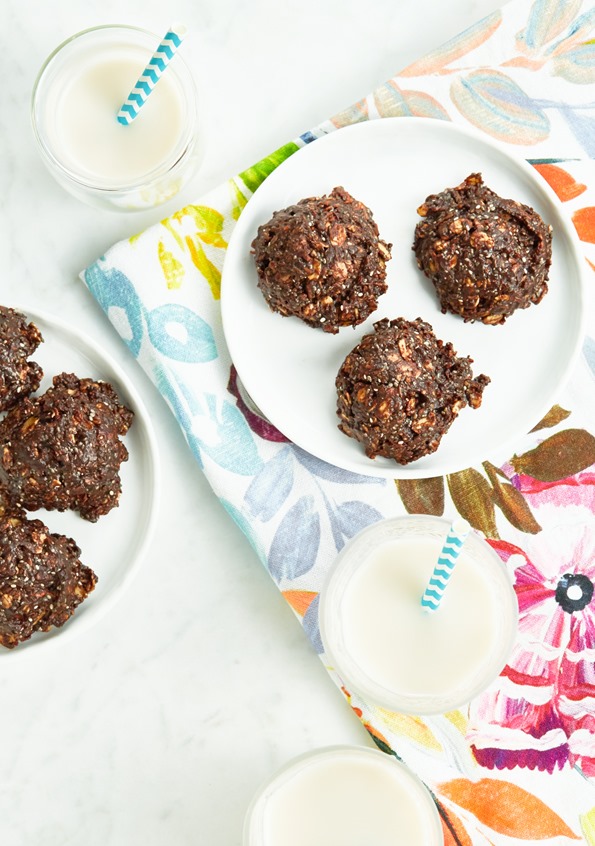
Happy Thursday! I hope you’re enjoying the week. Some of you have asked for more life updates in my blog posts, and I think that’s a fun idea to bring back more often! Without further ado, a little update and then the recipe…
Our week has been filled with a grab bag of things, as it usually is! On the business side, the Oh She Glows app work has still been filling our days and keeping us busy. I added 7 new recipes to the app over the past 2 weeks, so I’ve been a busy bee working around the clock! Each time I add a new app recipe I have to re-test the recipe (I also have one of my incredible recipe testers test it as well), re-write the recipe (especially if it’s a recipe published before 2013—let’s just say my recipe writing has changed over the years!), edit the recipe, shoot the photo, and then upload the recipe to the app testing site. From there, I position the recipe title, add metric conversions (all recent and future recipes will have metric conversions on the blog and in the app—major yay!), give the recipe a final edit, and make sure everything looks good before I make it live. (My OCD self usually checks it over a gazillion times.) I’m getting the hang of the process now and I really enjoy it. The great news is even if you don’t have the app you’ll still benefit, because as I’m revamping recipes, I’m adding the updated versions to the original blog posts. This means easier-to-follow recipes, and in many cases, even better-tasting recipes. Check out this video Eric put together below for a sneak peek of 6 recipes that were recently added to the app. I’m having so much fun with the photography.
On the home front, we’ve had quite a bit of excitement this week! You may have read in a recent In the Glow newsletter that this year we’re starting up the home renovation process once again (despite my pregnant self not wanting any part of it!), and right now we’re in the design phase. This week, we met with our designer to go over her drawings of the spaces. The design phase is my favourite phase (aside from when the renos are 100% complete, that is) because it’s all rosy and dreamy and filled with hopes of what could be. There’s no mess, no noise, no going over budget, and no dust (yet). So I love this stage, and Eric and I are pretty quick at making decisions together. We’re planning to finish the unfinished basement and a couple other projects before our second little one arrives in September. I must have fallen on my head to agree to this! Eric loves doing renos so I kind of gave in. I have to admit, going through the kitchen reno while 7–9 months pregnant in 2014 was pretty hellish (to put it lightly…hahah), but I’m hoping this process goes more smoothly since it’s not my kitchen that I’m giving up. NOBODY WANTS TO GIVE UP THEIR FOOD SANCTUARY…am I right? This is probably wishful thinking though. I figure that it’ll be easier doing the renos before the baby arrives because we all know when a newborn is in the house not much is getting done aside from feeding, changing scary diapers, and praying for more sleep. Plus, it would be great to have a finished basement where Adriana can have a real playroom! I’ll keep you guys posted on the journey and hopefully post some progress pictures in months to come.
Today’s recipe features one of the new recipes I uploaded to the app—my current favourite way to satisfy my chocolate fix! I didn’t want anything to do with chocolate during the first trimester, but lately I really crave it from time to time. Eric is so enthusiastic about these cookies I probably shouldn’t write the choice words he yelled out when he tasted them! (If you have our app, this recipe should automatically download when you open it next. Sometimes it can take up to 24 hours to display, but since I uploaded it yesterday afternoon it shouldn’t be long!)
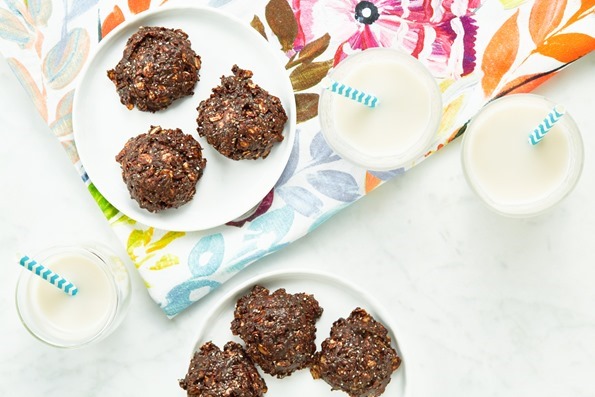
These no-bake fudge cookies are my quick and easy solution when a chocolate craving strikes! I start with a homemade coconut oil chocolate base (made even creamier with sunflower seed butter!), and add chia seeds for healthy Omega-3 fats, shredded coconut for a hint of macaroon flavor and texture, and of course rolled oats for the classic no-bake cookie ingredient. The cookies will soften a great deal at room temperature, so I recommend enjoying them straight from the fridge.
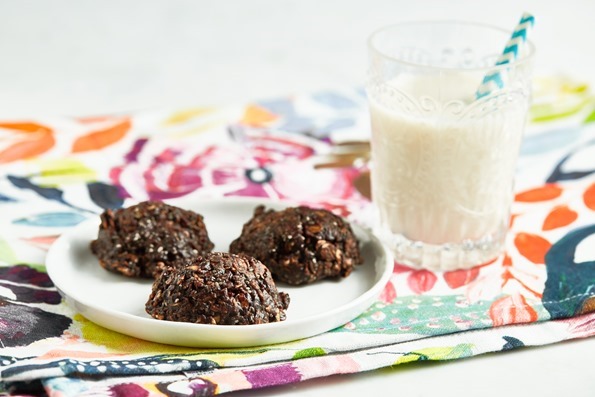
Last but not least, I forgot to announce in last Friday’s post who won the iPad giveaway and stand. A huge congrats to the winner (who was chosen randomly by Rafflecopter), Rochelle E., for winning these two awesome prizes! Rochelle, as I mentioned in my email, they will be on their way to you soon! A big thanks to everyone for entering the contest.
See you tomorrow for another installment of Friday FAQs!
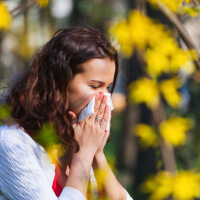

The three most important things in my life are God, my family, and my Instagram account, and not necessarily in that order… ~JP Sears
Bro, How long does it take you to take a picture? I can’t hold this all day…~(also) JP Sears
I apparently don’t spend enough time on Youtube or roll with the right crowd on Facebook because, well, I can’t say that I’ve ever seen an Ultra Spiritual Life episode starring JP Sears. How is that possible?! He’s hilarious!
My lovely wife sent me this spoofy collaboration between JP and real-life yoga photographer Brian Crawford poking a bit of good-hearted fun at a certain segment of the yoga world’s seeming obsession with striking the perfect pose in front of the camera. (Who doesn’t love seeing perfectly struck yoga poses against picturesque backgrounds?) I couldn’t help but laugh the whole way through the episode.
Great humor, great quotes–enjoy.

If you haven’t jumped on the guacamole train yet, these guac recipes are full of healthy fats and delicious flavors that are sure to get you hooked. Guacamole is kid-friendly, a perfect meal-prep snack, and the ideal dish for a party. Guys, Cinco de Mayo is RIGHT around the corner. Do you know what that...
The post Guac Recipes appeared first on Fit Foodie Finds.
When I was a teenager salad dressing was the enemy.
Sure I knew salads were the best choice for losing weight. But dressing, that evil temptress, tried her best to undo all the pain and suffering I just knew was necessary to get the body I wanted.
I remember once getting into an argument with my dad (the poor man had endured years of my refusing even a drop of fat on anything I ate).
He had made a substantial (and delicious) Cobb salad for dinner, and was offering me a bottle of low-fat ranch dressing to top it off.
I self-righteously retorted, “Salad dressing defeats the purpose of eating a salad.”
“No it doesn’t,” he explained with exasperation. “The purpose of eating a salad is to get your vegetables and leafy greens in for the day.”
Clearly we were speaking different languages.
I ignored his offering and forced down an enormous bowl of lettuce, egg whites, and non-fat ham. My dad took his salad and his dressing, and we went our separate ways.
In retrospect, neither of us were eating particularly healthfully or particularly unhealthfully. Sure we were eating salad, but we were also both observing the insane nutritional recommendations of the time to different degrees. Seriously, WTF is non-fat ham?
But clearly my dad understood something that I didn’t. That fat content wasn’t the only thing to consider when choosing food. That nutrition––and god forbid, taste––were also important.
I cringe when I think back to how Draconian I was about weight loss advice that has now been so thoroughly debunked. Not that 15-year old Darya stood a chance against dieting industry logic, but it is still painful to think about.
Yet even though that was 20 years ago, to this day I see self-proclaimed health conscious people throwing low-fat bottled salad dressing into their shopping carts and demurely asking for the real stuff “on the side.”
Please stop.
Salad dressing isn’t fattening or unhealthy. Yes it has calories, but you’re eating a freaking salad. You need some calories on there somewhere.
Having a bit of oil on your salad isn’t just acceptable, it’s actually healthier. The bioavailability (i.e. how much of a particular nutrient you can absorb from your food) of several vitamins, particularly carotenoids, are significantly increased in the presence of full-fat salad dressing, as opposed to reduced-fat or non-fat dressings.
Is it a coincidence that the way raw vegetables have been eaten for hundreds (maybe thousands) of years is the healthiest? Maybe. But it doesn’t really matter.
A fresh salad is delicious, and dressing makes it even better. Don’t serve it on the side, spend some time tossing it in a large bowl to be sure that every piece gets coated.
If you want it to be even healthier, stop buying the bottled stuff and make your own. It takes about two minutes and tastes worlds better. (You’ll also save money).
Remember that you need to enjoy the salads you eat if you want it to become a habit. That’s reason enough to make salad dressing your friend.
How long have you avoided salad dressing?
Originally published March 11, 2015.
You exercise regularly for months…then get derailed by a vacation, business trip, or just the general insanity of life. Sound familiar? Here’s how to stay in shape when you’re busy — it’s faster and easier than you think.
++++
It’s one of the most common patterns I see as a fitness and nutrition coach: People trying to get (and stay) in shape work out diligently for months — then get derailed by the holidays or a big deadline at work.
Many then “fall off the wagon” for the rest of the year.
It’s a seesaw that plays out physiologically too. Exercise regularly and you get a training effect — adaptations in the brain, circulatory system, respiratory system, metabolism, muscles, and bones that optimize health and function.
Stop exercising and your body starts adapting to that — doing nothing — so you start to lose all these benefits you worked so hard for.
That’s why we came up with this simple, do-anywhere workout. It takes only a few minutes a day, it requires minimal or no equipment, and it focuses on compound exercise (big muscles, big movements) so it’s certain to be effective.
It’s also adaptable: You can shuffle exercises around or skip a few of them, come up with different ways to add resistance, or modify the total number of reps and rounds according to how much time you have and your preferences.
The important thing is to get some full-body movement each day.
In the end, use this plan when you just can’t make your regular workout happen. It’ll help you maintain muscle, keep your metabolism humming, stave off fat gain, and more.
Download the infographic for your printer or tablet and bring it with you everywhere so you never get derailed again.

To make sure you have your stay-in-shape plan available next time life gets hectic, download the infographic and print a copy (or save it to your tablet).
And, if you’re a health or fitness coach, share the infographic with clients to offer support even in times when they can’t pull off their regular routine.
Most people already know that regular exercise and optimized nutrition are key to fitness and health. They just need smart solutions for making all of that happen — even when the other big priorities in their lives come knocking.
Precision Nutrition Coaching clients get one-on-one help figuring out how to fit big health goals into their busy daily routines. (We’ll be launching our next nutrition coaching program soon; to get a jump on it, check out this FREE starter kit for men and women.)
And the Precision Nutrition Certification teaches health and fitness professionals how to coach their own clients through the same challenges and get in the best shape of their lives.
The post How to stay in shape when you’re busy. [Infographic] appeared first on Precision Nutrition.

An idea worth spreading doesn’t just magically appear out of thin air. Instead, it needs a long incubation period, a sometimes frustrating — and often exciting — trial and error of creation, failure and innovation.
On April 18, TED welcomed its first-ever class of the TED Residency program, an in-house community of 28 bright minds who are tackling ambitious projects and making meaningful change.
This group of thinkers will spend the next four months in a collaborative space, learning with and from each other on ideas that address …
• How to talk about science differently
• The personal stories of migrants
• Violence prevention in at-risk communities
• Meaningful personal connections in a tech-heavy world
• Inclusion in the fashion world
• Building the digital Disney of Africa
• Frictionless housing for a mobile society
… among many other fascinating subjects
At the end of the session, the residents will give a TED Talk about their final ideas in TED office theater. Read more about each resident below:
Daniel Ahmadizadeh is working with artificial intelligence to revolutionize how consumers are informed and make choices. He co-founded Riley, a chatbot concierge service that saves real-estate professionals time. Riley handles the preliminary conversation with a prospect on behalf of agents 24/7 via text message.
Piper Anderson is a writer, cultural worker, and founder/chief creative strategist at Create Forward, a social enterprise that designs creative strategies for social change to activate the collective imagination. Inspired by her 15 years working on local and national initiatives to end mass criminalization and incarceration, she launched the National Mass Story Campaign, which will host participatory storytelling events in 20 cities to catalyze more restorative and transformative approaches to justice through stories and dialogues with people directly impacted.
Isabel Behncke is a Oxford field primatologist from Chile working on the evolutionary roots of social behavior in humans and other animals. As part of her interest in “the evolution of the ideas-talk,” she is creating a show on the Science of Joy that blurs boundaries between theatre, poetry and cutting-edge science. Think ancient fireside storytelling, but with Rolling Stones, Whitman and Darwin as part of the hearth.
Susan Bird is working to build a podcast series of meaningful conversations. As face-to-face connection is now considered a new luxury, Susan hopes to create a global appetite for conversation and feed it with the skills needed to spread ideas.
Artist and traveler Reggie Black looks to inspire others through Sticky Inspiration! Sticky Inspiration started as an online project designed to inspire others through thought-provoking quotes composed and distributed daily in public spaces. After five years, he’s looking to continue and expand on his idea through tangible experiences to create an even bigger impact.
Sashko Danylenko is a Ukraine-based filmmaker whose animated films explore wonder and curiosity. Currently, Sashko is working on a film that documents different cities around the world as seen through bicyclists.
Tanya Dwyer is an attorney and social entrepreneur in Brooklyn who works to promote inclusive capitalism and economic justice. She wants to help establish a living-wage business park in Crown Heights that is cooperatively owned by neighborhood residents and stakeholders.
Laura Anne Edwards wants to enlist the global TED community to help create DATA OASIS, a dynamic index and treasure map of open data archives and a wiki-style forum for sharing best practices and APIs across disciplines and borders. DATA OASIS will reduce redundant research projects, thereby moving critical efforts forward such as environmental science and medical studies. It will also radically democratize access to valuable data sets, many of which are taxpayer funded and technically “open” but in practice, extremely difficult to locate and access.
Rob Gore, an academic emergency medicine physician doc based in Brooklyn, leads KAVI (Kings Against Violence Initiative), a youth empowerment program and violence prevention program that has been running for the past five years. His work explores the intersection of medicine and empowerment and hopes to transform health care in marginalized populations.
Che Grayson is a filmmaker and comic book creator whose multimedia project Rigamo, a comic series and short film about a young girl whose tears bring people back to life, helped her overcome her grief at the death of a beloved aunt. She wants to explore using these forms of storytelling to tackle other tough subjects, heal, and inspire.
Bethany Halbreich runs Paint the World, an organization on a mission to discover what could happen if we make opportunities for creativity ubiquitous. Paint the World facilitates public art projects in underserved communities, the resulting pieces are sold and the profits fund more kits and supplies for areas in need — and so the cycle repeats!
Sarah Hinawi is the co-founder and director of Purpl, a small-business incubator that focuses on the person rather than the business. Her career has been driven by a desire to help others find self-direction, a personal connection to learning and a life path in line with their passions, interests, and beliefs. Her latest work examines what a new model of leadership looks like in the gig economy and how fostering this model can address the disengagement and isolation so omnipresent in our workforce.
DK Holland has developed a free afterschool program where third through fifth graders take the lead. Kids’ Council is a micro-democracy run by kids in their classroom. DK finds that giving kids the opportunity to serve motivates even the quietest, most challenged child to express his or her natural generosity, inquisitiveness, individualism and sense of fairness. She is working on making this new model accessible to other public schools across the US. She’s finding that many kids are natural innovators and they consult with Inquiring Minds USA, her company, to bring progressive learning improvements back in to their classrooms, notably the Learning Wall and Portfolio Pockets.
Liz Jackson is the founder and Chief Advocacy Officer for the Inclusive Fashion & Design Collective, which is the first fashion trade association for businesses and designers serving the needs of people with disabilities. Their mission is to introduce the world to inclusive design and use it to fuel the disability market, which is an emerging market the size of China.
Ayana Elizabeth Johnson is a marine biologist and policy expert who advocates zoning the ocean as we do land. As executive director of the Waitt Institute, she led the Caribbean’s first successful island-wide ocean zoning project, resulting in one third of Barbuda’s coastal waters being protected, and went on to launch similar initiatives on other islands. Ayana argues that this big-picture approach can frame political, environmental, cultural and economic tradeoffs; set a course toward restoring the ocean’s abundance; and enable us to use the ocean without using it up.
Jonathan Kalan and Michael Youngblood are rethinking the future of flexible housing through their company Unsettled. They want to redefine the notion of home and its relation to work for a more mobile generation. The rise of the sharing economy has proven that our generation values experiences over ownership, and this duo is pioneering the first truly “global lease,” a subscription-based platform for global housing that will unlock a location-independent, experience-driven lifestyle.
Brian McCullough is the creator of the Internet History Podcast, an oral history of the internet. Regarded as the informal textbook to the historical evolution of the web, Brian’s work serves as a tool to educate those that work in that space.
Christia Mercer is a full-time Columbia philosophy professor and part-time activist. She plans to examine radically different answers that people across cultures and times have given to hard questions and show their relevance to modern thinking.
Ted Myerson is a co-founder of Anonos, a Big Privacy technology company that enables data to be more readily collected, shared, published and combined. As Big Data paves the way for new discovery, Ted hopes to improve quality of life with privacy-respectful life science breakthroughs that could empower personalized and precision medicine.
As a tap dancer, Andrew Nemr has lived the oral tradition of American Vernacular Dance. Along with dance legend Gregory Hines, Andrew has co-founded the Tap Legacy Foundation and is working to create an online platform for the preservation, support, and promotion of oral traditions.
Cavaughn Noel is looking expose urban youth to the untapped fruits of life that they rarely get to experience, using inspirational imagery, via technology, arts, fashion, and travel. By creating a platform to serve as a “lens” for young people to see opportunities around the world, he wants to empower them to build their own inroads in those spaces once they see what is possible.
Torin Perez is building a digital platform to bridge the massive gap in availability and accessibility of diverse children’s content for schools and families. The DreamAfrica app is home to engaging and educational family-friendly multimedia content from established publishers, independent content creators, and children.
Amanda Phingbodhipakkiya is a Columbia-trained neuroscientist turned art director and is founder of The Leading Strand. Her organization directs designer-researcher collaborations to produce visual media that reveal the incredible possibilities hidden behind the often inaccessible language of academic science.
After her Flappy Bird in a Box video went viral, Fawn Qiu wondered how else she could hook teens on engineering. By creating an open-source model for designing fun projects with low-cost, everyday objects, she hopes to encourages a new generation of engineers.
Vanessa Valenti is the co-founder of FRESH, a next-generation speakers’ bureau focused on diversifying the speaking field. She’s conducting research to inspire us to redesign thought leadership—specifically, who gets on the world’s most influential stages, and what their experiences are once they get there.
Kimberlee Williams is the CEO of FEMWORKS, a communications agency specialized in developing authentic and enduring community connection through events, engagement strategies and creative content. She wants to transform local economies by better engaging and enrolling African American consumers in buy-local campaigns.
Sheryl Winarick‘s work as an immigration lawyer gives her the unique opportunity to know intimately the people she serves, the reasons they choose to migrate, and the challenges they face. She is constantly in awe of the qualities that emerge when people leave the familiar behind for an uncertain future. She aims to create an online storytelling platform to humanize “the other,” to inspire and educate, to connect and collaborate, and to cultivate a sense of individual and collective responsibility.

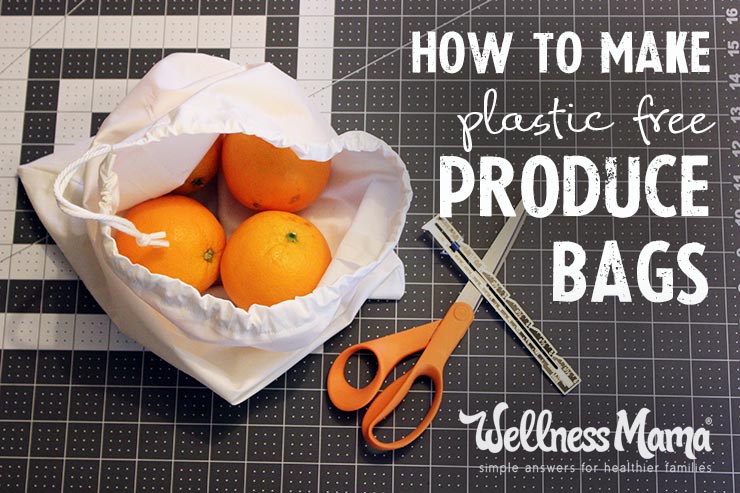
Imagine yourself in the grocery store picking out the perfect collection of organic apples. You look around, only to discover that you have no option other than to put your fruit into a plastic bag. Not only are they thin and easily torn, they expose your food to the dangers of plastic and have a negative impact on the environment.
There are many non-plastic options for produce bags but did you know they are incredibly easy to make yourself? In fact, I spent more time setting up my sewing supplies than I did actually sewing! (Only very basic sewing skills are required for this super easy DIY project.)
Depending on the supplies you use, these reusable produce bags can be made for next to nothing. You can repurpose a worn or out-dated t-shirt and a spare shoelace as a drawstring for a virtually free bag.
No matter what supplies you use, this easy tutorial will show you how to make you own produce bags to take along on your next shopping trip.
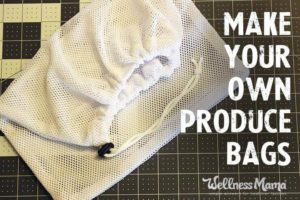 Fabric: This is a matter of preference. I have used both organic cotton muslin and a lightweight polyester mesh with a light stretch. As I mentioned above, an old t-shirt or any other lightweight fabric you have on hand will work well. Remember that your bag will be weighed along with your produce so you don’t want to add more weight than is necessary.
Fabric: This is a matter of preference. I have used both organic cotton muslin and a lightweight polyester mesh with a light stretch. As I mentioned above, an old t-shirt or any other lightweight fabric you have on hand will work well. Remember that your bag will be weighed along with your produce so you don’t want to add more weight than is necessary.
I did make sure that the fabric was washable before I chose one. Some mesh fabrics require special care when washing but I want to be able to toss it in with my regular laundry if/when it becomes soiled.
The organic cotton muslin was the easiest to work with and cinched very well with the drawstring, so this is what I would recommend for a beginner. Plus you have the added benefit of using organic fabric.
Bag Closure Options: There are several ways you could finish the top of your produce bags:
The absolute easiest way would be to just finish the edge with a simple hem. This technique would leave the top of your bag open similar to the plastic bags provided at the store. The drawback would be that your produce would have the possibility of falling out of the bag. However, you could use a silicone bag clip to fasten it, keeping everything safely inside.
Another simple solution is to use elastic. I would not recommend this if you buy a lot of bulk nuts or other small items but it works great for larger things like apples, tomatoes, and avocados. Just measure a piece of 1/4″ wide elastic (measure with the elastic fully stretched) the same length as the circumference of your bag plus 1/2″ for overlap. Then insert it into a casing the same way you would for an elastic waistband.
The closure type I most prefer is a drawstring. I purchased a 1/8″ cable cord and also later realized that a large round shoelace would work well. The cotton muslin stayed closed quite well but the mesh slipped a bit on the drawstring so I put a cord lock on that bag for added security.
Other Supplies
This tutorial will show you how to make a drawstring produce bag that is roughly 12″ wide by 14″ long using a lightweight organic cotton muslin. Use 1/2″ seam allowances unless otherwise stated.
1. Lay your fabric out so that it is 2 layers thick.
2. Cut a 13″ by 16″ rectangle (this will give you 2 pieces).
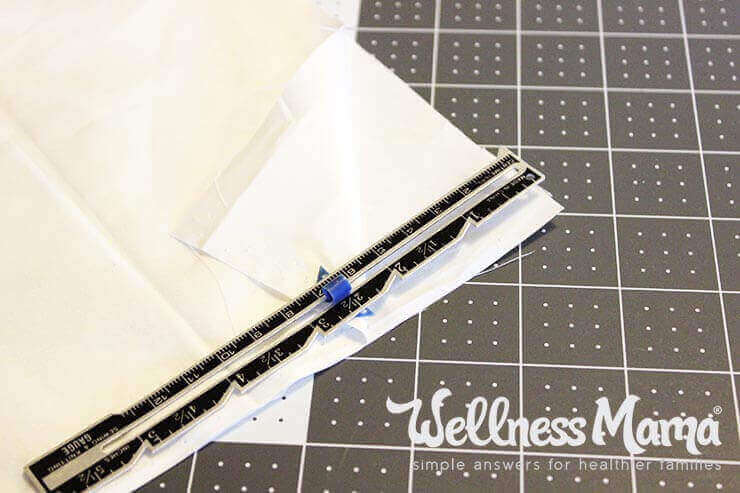
3. With the 2 pieces together, measure down 2.5″ on one of the long ends. Mark this spot with a straight pin. You will leave these 2.5″ open to leave room to make the drawstring casing.
4. Starting at the straight pin you placed in step 2, sew a seam around the rectangle on 3 sides, leaving the last side (top of bag) and the 2.5″ on the side open.
5. Along the top edge, fold over 1/2″ to the wrong side and press with your iron.
6. On the side with the open section, press open the seam allowance including the 2.5″ opening.
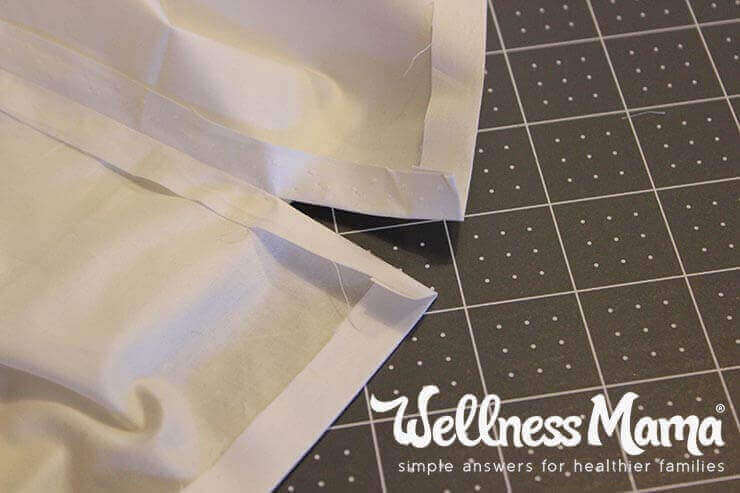
7. Starting at the top edge, stitch down to the bottom of the 2.5″ opening. Stop, pivot, and sew across the side seam about 1″. Stop, pivot, and sew back up the other side, ending at the top edge.
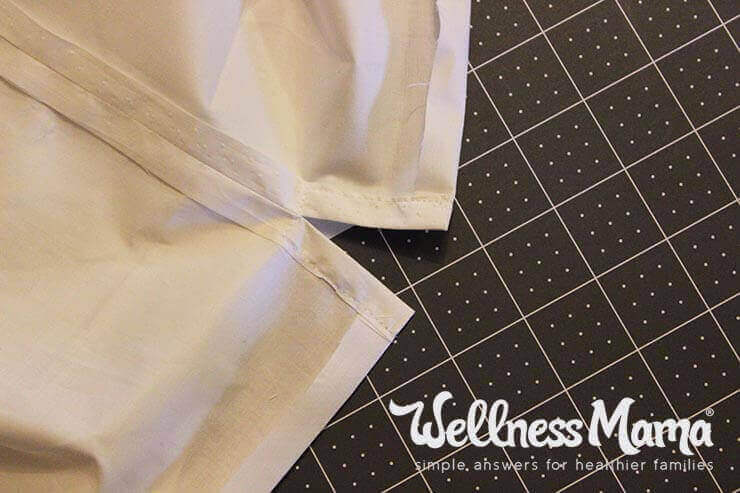
8. To make the casing for the drawstring, fold over 1″ around the top edge to the wrong side and press.
9. Stitch all the way around just inside the bottom of the 1″ fold forming a casing for your drawstring.
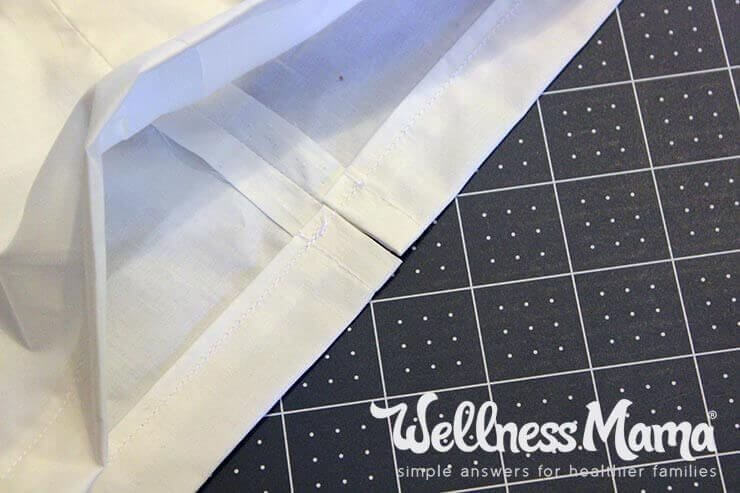
10. Cut the 1/8″ cable cord long enough to go all the way around the bag through the casing and have enough to tie a knot. I cut mine about 34″.
11. Wrap a piece of tape around each end.
12. Put the safety pin through one taped end of your cord and use it to feed the cord through the casing.
13. Put both ends together and tie an overhand knot.
I also made a smaller size that would be handy for buying things like kiwi, ginger root, or 3-4 average sized apples. The finished size of the smaller bag was 8″x 10″ so I cut the initial pieces 9″x 12″.
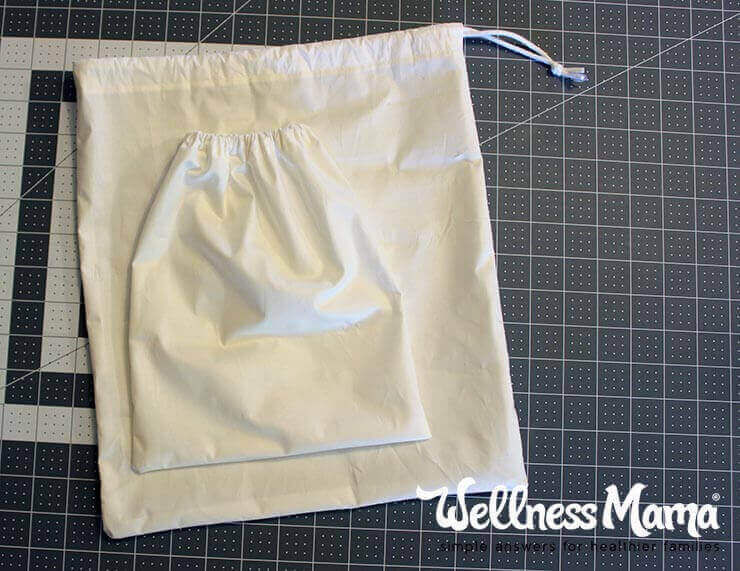
You can really make any size you would like. Just take the finished dimensions you want and add 2″ to the long side of the bag (so you have plenty of room to make the casing for the drawstring) and 1″ to the width.
Making the switch to cloth produce bags is an easy way to reduce plastic use in your daily life. Here are some other tips.
Ever made your own grocery bags? What other changes have you made to avoid plastic?
Continue Reading...How to Make Your Own Produce Bags